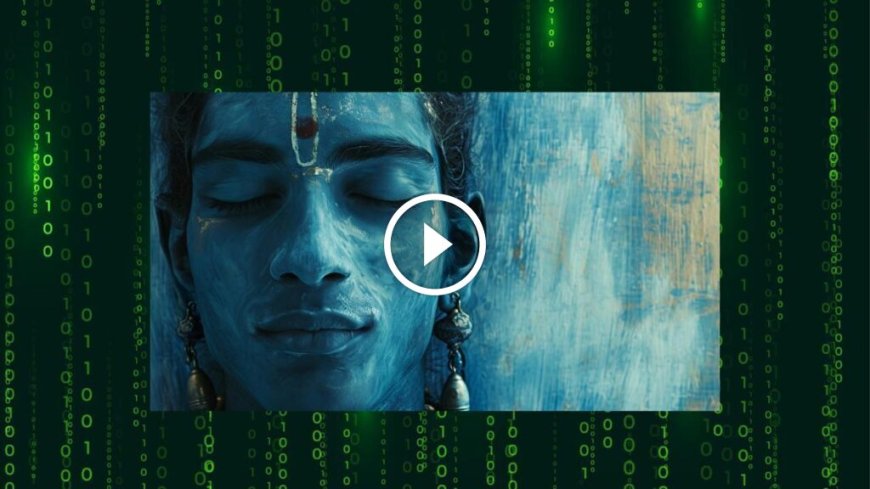Revisiting ‘What is Real?’ as The Matrix (1999), the first installment in the Matrix film series, celebrates its 25th year since its release
Morpheus’s explanation to Neo’s question: ‘What is the Matrix?’ was perhaps the most awaited moment in the movie, which won best Film Editing, best Sound, best Sound Effects Editing and best Visual Effects during the 72nd Academy Awards. There are many things in the movie that are worth talking about. However, the most crucial point, this twenty five […] The post Revisiting ‘What is Real?’ as The Matrix (1999), the first installment in the Matrix film series, celebrates its 25th year since its release first appeared on Storify News.

Morpheus’s explanation to Neo’s question: ‘What is the Matrix?’ was perhaps the most awaited moment in the movie, which won best Film Editing, best Sound, best Sound Effects Editing and best Visual Effects during the 72nd Academy Awards. There are many things in the movie that are worth talking about. However, the most crucial point, this twenty five year old film, focussed on, was the question of ‘What is Real?.’ This is something the Indian philosophers have been engaged with eversince the origins of the different schools of Hindu philosophy. Morpheus, a human freed from the matrix and captain of the fictional hovercraft called Nebuchadnezza, in the movie The Matrix, perhaps have attended to the question by saying that matrix is a construct. In fact it was like being inside a computer programme and electric signals interpreted by a person’s brain.
The Matrix, released towards the end of the twentieth century, aimed to define the matrix as the world as it was at the end of the twentieth century. The Matrix, was thus, a computer generated dreamworld built to keep human beings under control.
Neo, the computer programmer, during his conversation with Morpheus made his hands run over the cracked leather, emphasized on touch as the conversation slowly proceeded to feeling, taste, smell, sight in order to define electric signals interpreted by the brain. The conversation gradually became more interesting and intriguing as it showed the existence of the world as part of neural interactive stimuli. This was known as the matrix. The definition of matrix also incorporated Artificial Intelligence, the dependence on solar power as well as on machines throughout ages.
Though this is just an excerpt of the highest Warner Bros. film made in 1999, what is to be noted is the impact it has created in the audience. Without a doubt, it once again generated the interest in the question: ‘What is Realism?’ and what could be the futuristic answer to the question, keeping in mind the rich debates on realism and idealism which also has its origins in the Hindu schools of thought.
The Indian philosophical traditions offer diverse and intricate perspectives on realism and idealism. The realistic schools acknowledge the objective existence of the material world while recognizing the limitations of human perception. The idealistic philosophies emphasize the primacy of consciousness and the illusory nature of the material world. Throughout Indian thought, there are examples of reconciling these contrasting perspectives, giving a holistic worldview that incorporates both realism and idealism.
These Indian perspectives challenge us to question our assumptions about reality, consciousness, and the interplay between the material and the spiritual realms. They provide frameworks for spiritual growth, ethical living, and harmonious societal interactions. Moreover, the Indian philosophies offer avenues for dialogue and integration with science, stimulating a deeper understanding of the nature of existence.
By exploring the rich heritage of Indian philosophy and engaging with these contrasting perspectives on realism and idealism, we can broaden our understanding of the complexities of human existence and open up new avenues for personal and collective growth.
What is the difference between Idealism and Realism?
The debate between idealism and realism in the Hindu Philosophical Schools of thought have been a cornerstone in the history of Indian Philosophy. Both idealism and realism, as philosophical terms, deal with the relationship between our minds and the world.
On one hand Idealism is of the opinion that things exist only as ideas with no reality as material objects outside the mind. On the other hand, realism is the belief that the objects exist in themselves, independently of their consciousness. It is said that the philosophical traditions of India have given keen insights into the domain of realism and idealism, giving unique viewpoints that split from Western philosophical frameworks. The Indian philosophical systems like Buddhism, Vedanta and Samkhya offer comprehensive views on the nature of reality and the relationship between the material world and consciousness.
Realism in Indian Philosophy
Realism in Indian philosophy holds that the external world exists objectively and independently of human perception. It puts forward that our senses provide us with direct knowledge and external reality. However, Indian realists admit the limitations and subjectivity of human perception. They argued that our senses are capable of making mistakes and can be influenced by numerous factors, leading to perceptual errors. Despite these limitations, realism in Indian philosophy asserts that the material world has an ontological existence.
i) Nyaya and Vaisheshika
The Nyaya and Vaisheshika schools of philosophy are notable subscribers of realism in Indian thought. Nyaya philosophers such as Gautama and Vatsyayana argued that perception (pratyaksha) is valid means of knowledge, giving direct access to external objects. Vaisheshika, whose foundation was laid down by Kananda, presented a detailed ontology of the material world, postulating that reality consists of distinct, atomic entities that combine to form complex objects.
ii) Mimamsa
Mimasa, developed by Jamini, highlights the importance of ritual practices and the Vedic scriptures. Mimamsa emphasizes more on the practical aspects of religious and ritualistic observances even after stressing on the objective reality of the world.
Idealism in Indian Philosophy
Idealism in Indian philosophy posits that reality is ultimately a product of consciousness or mind. It argues that the external world is an illusory projection, and ultimate truth lies in the realm of consciousness. Indian idealism further describes the material world as ephemeral and constantly changing while consciousness is eternal and unchanging.
i) Advaita Vedanta
Advaita Vedanta, whose foundation was laid down by Adi Shakara, is considered to be one of the most influential idealistic philosophies in India. It propounds the doctrine of non-dualism, asserting that the ultimate reality, called Brahman, is identical with individual consciousness (Atman). Advaita Vedanta is of the belief that the material world, known as Maya, is an illusion that veils the true nature of reality. Liberation or Moksha is achieved through the realization of this non-dualistic nature of existence.
ii) Buddhist Philosophy
Buddhism, particularly the Mahayana tradition, presents a unique form of idealism called Yogacara or Vijnanavada. It advances that reality is fundamentally mind dependent and the external world is the construct of the consciousness. The view held by Yogacara is that every phenomena are manifestations of mind, and liberation is achieved through transcending conceptual limitations and recognizing the true nature of mind.
Interplay between Realism and Idealism in Indian Thought
Indian philosophy often welcomes a holistic way, recognizing the interplay between realism and idealism. While some scholars are more inclined towards realism or idealism, others attempt to reconcile the two viewpoints.
i) Samkhya Philosophy
Samkhya philosophy, a school of thought easily recognized with sage Kapila, introduces a dualistic worldview that incorporates elements of both realism and idealism. Samkhya posits the existence of two fundamental entities, namely, Purusha (Consciousness) and Prakriti (matter). Purusha represents pure consciousness, while Prakriti is the material sphere consisting of various elements. Samkhya is of the view that liberation is gained through the realization of the distinction between Purusha and Prakriti, thereby transcending the identification with the material world and acknowledging the greater importance of consciousness.
ii) Vishishtadvaita Vedanta
Vishishtadvaita Vedanta, circulated by Ramunaja, gives a qualified non-dualistic outlook. It acknowledges the reality of the external world while focusing on the interconnectedness of all beings with the ultimate reality (Brahman). According to Vishishtadvaita Vedanta, the material world is an expression of the divine and serves as a means for spiritual evolution and realization.
iii) Jaina Philosophy
Jaina philosophy, founded by Mahavira, acknowledges the existence of both the material world and consciousness. It propounds that reality consists of both dravya (substances) and jiva (souls). Jainism highlights the independence of the material and spiritual domain and advocates for the purification of consciousness through ethical living and self discipline.
Implications and Relevance of Indian Perspectives
The Indian perspectives on realism and idealism have profound implications for our understanding of existence, consciousness and nature of reality. They challenge the reductionist inclination of Western philosophies and give a more holistic and nuanced view of the world.
i) Spiritual Growth and Liberation
The Indian idealistic philosophies, such as Advaita Vedanta and Yogacara Buddhism emphasize the realization of non-duality and the liberation of consciousness from the illusion of the material world. They provide spiritual paths that prioritize self-realization and the transcendence of egoic identification with the external world.
ii) Ethical Living and Social Harmony
Numerous Indian philosophies, both realist and idealist, underline the significance of ethical living and social responsibility. They support compassion, non-violence and the welfare of every being constituting essential components of spiritual growth and societal harmony. These viewpoints have practical applications in fostering social justice, environmental sustainability and the well being of communities.
iii) Integration of Science and Spirituality
The Indian perspectives on realism and idealism offer opportunities for dialogue and integration with scientific inquiries. The deep exploration of consciousness, mind-body connections, and the nature of reality aligns with current scientific research in fields like quantum physics and cognitive sciences. Indian philosophies provide frameworks for bridging the gaps between scientific exploration and spiritual understanding.
Exciting news! Storify News is now on WhatsApp Channels. Subscribe today by clicking the link and stay updated with the latest news! Click here!
The post Revisiting ‘What is Real?’ as The Matrix (1999), the first installment in the Matrix film series, celebrates its 25th year since its release first appeared on Storify News.





































